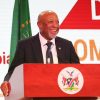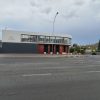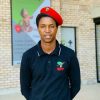Omanyano ovanhu koikundaneki yomalungula kashili paveta, Commisiner Sakaria takunghilile
Veronika Haulenga
Omanyano ovanhu koikundaneki yomalungula kashili paveta, Commisiner Sakaria takunghilile
Veronika Haulenga
Listeners:
Top listeners:
-
play_arrow
Omanyano ovanhu koikundaneki yomalungula kashili paveta, Commisiner Sakaria takunghilile Veronika Haulenga
Democratic Republic of the Congo: Little Justice for Goma Massacre Victims
Democratic Republic of Congo authorities should expand their investigation into security force personnel responsible for killing scores of people in eastern Congo one year ago, Human Rights Watch said today. The government should also provide prompt and adequate compensation to victims or their families.
On August 30, 2023, Congolese security forces killed at least 57 people in Goma, the capital of the North Kivu province. Most were members of a mystic religious group, the Natural Judaic and Messianic Faith Towards the Nations (Foi Naturelle Judaique et Messianique vers les Nations), who were preparing a protest against the United Nations Stabilization Mission in the Democratic Republic of the Congo (MONUSCO). A United Nations panel of experts and Human Rights Watch found that the actual death toll was most likely significantly higher. A military court in October found four soldiers, including a commanding officer, guilty of murder, but no further investigations appear to be ongoing and no victims have received compensation.
“One year on, Congolese authorities have successfully prosecuted several people for the 2023 Goma massacre, but the investigations have been severely limited, and no compensation has been paid to victims,” said Lewis Mudge, Central Africa director at Human Rights Watch. “Establishing command responsibility and appropriately punishing all those responsible is crucial to preventing similar abuses in the future.”
On July 30, 2023, Ephraim Bisimwa, the leader of the mystic religious movement, announced a protest against MONUSCO to be held on August 30 to demand the UN mission’s departure by the end of the year due to its inability to stem protracted fighting in the east.
On August 23, the mayor of Goma issued a communiqué banning the protest. Bisimwa called off the demonstration and asked his members to meet at his church on the morning of August 30. The UN panel reported that the military and police chain of command sent down reports that the group’s protests were connected to rumored plans by the M23 rebel group and its Rwandan backers to destabilize the city. Since late 2022, Rwanda-backed M23 rebels have committed unlawful killings, rape, and numerous other grave abuses in eastern Congo.
On August 30, between 3 and 4 a.m., Congolese soldiers raided a radio station affiliated with the movement in Goma’s Ndosho neighborhood. Bisimwa was at the station and used a WhatsApp message to inform his members of the raid. When soldiers took Bisimwa and eight others out of the station, his members arrived. Soldiers opened fire on them, killing six members outside the radio station, and then departed with Bisimwa and a colleague. Bisimwa later told Human Rights Watch: “They took us to the [Republican Guard]’s base where they tied us up, made us lie on the floor, then they threw water on us and beat us with sticks.”
Following the deadly raid, members of the group captured a police officer, bound his hands, and took him back to the group’s headquarters, commonly referred to as its temple.
In the confusion that followed, the police shot some members of the group, killing Bisimwa’s son. Some members then returned to the temple and killed the abducted police officer. Footage verified by Human Rights Watch shows the officer lying on the floor, hands tied, and curled up into a ball, while people beat him with sticks and threw rocks at him, killing him.
Soldiers arrived at the temple around 7 a.m. and Republican Guards followed. Col. Mike Mikombe, the Republican Guard commander in Goma, took over negotiations with a growing crowd. An officer who was there later told Human Rights Watch that once Mikombe arrived, tensions quickly arose.
Human Rights Watch verified a video filmed at the scene around 7 a.m. which shows Mikombe and Maj. Peter, commander of a Republican Guard special forces unit, addressing the members in an alley adjacent to the temple, flanked by special forces personnel. In the footage the soldiers are wearing full combat gear and carrying weapons. Witnesses said at least four drones were flying overhead.
Minutes after the arrival of the Republican Guard commanders, shooting began. “I don’t know what the colonel from the Republican Guard saw to give the order to shoot at us,” a group member said. Several witnesses reported that Mikombe lifted his handgun in the air and ordered Republican Guard soldiers to open fire. One man said Mikombe shouted, “Bofungola nzela!” (“Open the path!” in Lingala). Human Rights Watch research, including interviews with national army officials, indicated that the movement members were unarmed.
The soldiers fired with military assault rifles on the demonstrators and bystanders, killing and wounding dozens while others ran for cover. Many took refuge in neighboring houses or inside the temple around the corner. The gunfire was continuous for several minutes. Human Rights Watch verified a video filmed at the scene showing clouds of dust filling the alley as automatic gunfire is heard. Walls of surrounding houses and the temple were struck, killing and wounding people who were taking cover inside both. Human Rights Watch examined bullet holes in the walls of many houses at the scene.
A woman who took cover in her house with her younger brother said a woman and a boy were killed inside her compound, where they had sought safety. “I didn’t know them, and they didn’t seem to know each other either,” she said. “They had come to hide when the shooting began.”
Some people taking cover in houses filmed the immediate aftermath of the shooting on their cell phones. Several videos show numerous bodies on the streets. A man who witnessed the killings from a house near the temple said the soldiers walked among the bodies to check if anyone was still alive. “They would shoot at the wounded to kill them once and for all,” he said.
Immediately after the shooting stopped, soldiers loaded bodies onto at least one military truck. Video footage verified by Human Rights Watch shows soldiers dragging bodies along the street, pulling them by the legs or arms in a degrading manner. Additional footage shows them throwing bodies onto the trucks, piled onto one another. Several wounded people were also forced onto the same truck.
The soldiers rounded up dozens of people, including children, in the temple courtyard. Many were later arrested. Footage verified by Human Rights Watch shows members of the Republican Guards walking away with looted goods, furniture, and livestock on a street near the temple. Between 9:30 and 10 a.m., Republican Guards and other soldiers set the temple on fire. Human Rights Watch verified a video that shows the temple on fire.
In September and October, a military court tried Mikombe and five other soldiers. Three were sentenced to ten years in prison, while two others, including Mikombe’s deputy, were acquitted. On October 2, Mikombe was found guilty of murder and sentenced to death.
The case against Mikombe did not address the role played by higher-ranking officers who might have ordered or otherwise be criminally liable for the crimes committed. The authorities did not establish an exhaustive count of the dead. They did not investigate allegations that soldiers executed wounded people or burned the temple. In its final report, the UN panel of experts raised doubts about the investigation.
Further investigations should be conducted to establish whether officers senior to Mikombe were liable for these crimes, Human Rights Watch said.
Because the North Kivu province is under military rule, a military court tried Bisimwa and 63 other movement members for killing the police officer. All were sentenced to 10 or more years in prison or to death. The UN panel of experts said no evidence was presented at the trial to link the defendants with direct participation in killing the officer. Bisimwa had been in military custody for several hours prior to the killing.
The government commuted all death sentences to life in prison.
Victims or their families should receive prompt and adequate compensation for their loss, Human Rights Watch said. A movement member whose wife was killed said: “I would like us to be compensated for the damage that has been done to us. Looking after seven children without their mother is something that is very difficult for me. We need assistance.”
In addition to expanding their investigation of those responsible for the government killings and providing compensation to victims, the Congolese authorities should address its crowd control measures. The military generally should not be used for law enforcement, a function for which the police are better trained. Any security forces used for crowd control should receive proper training, equipment, and oversight. The Congolese government should seek international support to ensure that its security forces abide by regional and international standards on the use of force.
“The victims of the Goma massacre still await accountability,” Mudge said. “All those responsible, regardless of rank or standing, should be prosecuted, and those harmed promptly and fairly compensated.”
Distributed by APO Group on behalf of Human Rights Watch (HRW).
Similar posts
Windhoek Weather
Most popular

Mbumba signs off new benefits for retired political office bearers

Former FNB employee arrested after defraud pensioner off N$215, 000

Namdia Heist: More questions, lots of confusion

Omuhwahwameki Michael okuunganeka oshikonga shoku patitha oostola dho Rani moshilongo ashihe.

Walvis Bay woman loses over N$777.000 to a fraudster
Copyright 2025 Future Media (Pty) Ltd | Website by Digital Platforms
Tel: +264 83 000 1000 | Email: news@futuremedia.com.na



